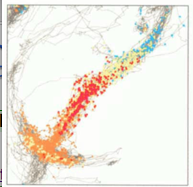Topic 3: Spatial Knowledge
Animal studies have shown that the hippocampus contains special cells called “place cells”. These place cells are interesting because their activity seems to indicate not what the animal sees, but rather where the animal is in space as it runs around in a box or in a maze. (See the four cells in the image to the right.)
Further, when the animal goes to sleep, those cells tend to reactivate in the same order they did during wakefulness. This apparent retracing of the paths during sleep has been termed “hippocampal replay”.
More recently, studies in humans — who have deep microelectrodes implanted to help detect the origin of epileptic seizures — have shown place-responsive cells. Place cells in these studies were found not only in the human hippocampus but also in nearby brain regions.
The computation which converts sequences of visual and other cues into a sense of “place” is a very interesting one that has not yet been fully explained. However, there do exist neural network models of the hippocampus that, when presented with sequences, exhibit place-cell like activity in some neurons.
The notion of place cell might also extend beyond physical space. It has been speculated that computations occur to convert sequences events and situations into a distinct sense of “now”. And indeed, damage to the hippocampus has been found not only to impair spatial memory but also “episodic” memory, the psychological term for memory for distinct events.
Experiments?
How can we understand the ways in which we understand space? Understanding spatial knowledge seems more tangible than understanding the previous two topics in this series. It seems that researchers are already using some of the most effective methods to tackle the problem.
First, the use of microelectrodes throughout the brain while human participants play virtual taxi games and perform problem solving tasks promises insight into this question. Second, computational modeling of regions (e.g., the hippocampus) containing place cells should help us understand their properties and how they emerge. Finally, continued animal research and possibly manipulation of place cells in animals to influence decision making (e.g., in a T-maze task) may provide an understanding of how spatial knowledge is used on-line.
-PL

The hippocampus is also one of only two parts of the human brain that makes new neurons after our birth. It’s not clear whether this neurogenesis is necessary for the fully-functioning spatial knowledge and memory, but new experiments in bats suggest that it isn’t.
Bats clearly have excellent spatial awareness and fruit-eaters in particular need superb spatial memory. And yet, a new study finds that 9 of 12 bat species have no hippocampal neurogenesis at all, while the other showed only low amounts.